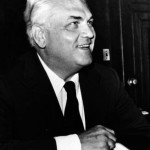By Elliott Brack | If George Sparks shepherded Georgia State University in its middle years, the major figure propelling the university into the future was no doubt Noah Langdale. He was president from 1957 until 1988, seeing it grow from two buildings with $1.9 million budget and 5,200 students, and offering one degree, to 22,000 students and 20 buildings, a budget of $118 million and with 50 degrees in more than 200 fields. Today GSU could soon have more than 50,000 students, as Georgia Perimeter College is to merge with GSU.
 Langdale was a football lineman at Alabama, and later a “burly orator” and erudite man, who got his law degree from Harvard. He had a voracious vocabulary, and was a walking, talking force for his school.
Langdale was a football lineman at Alabama, and later a “burly orator” and erudite man, who got his law degree from Harvard. He had a voracious vocabulary, and was a walking, talking force for his school.
But before the Langdale’s reign, GSU had to survive a long and continuing brawl with the University of Georgia, and its president, O.C. Aderhold, over control of courses, spending, faculty and expansion. The wrangle became public. At one time the Southern School of Pharmacy in Atlanta asked the University System Regents to take over its operation under the jurisdiction of what would become GSU. Aderhold and the University objected, since it had its own pharmacy school, and didn’t want it hampered. (Eventually the Southern College of Pharmacy merged with Mercer University of Atlanta.)
Among recriminations between the two campuses was that the Atlanta campus had offered courses on an experimental basis, which quickly became permanent in the catalog. Athens officials were upset. The quarrels continued over personnel, courses, administrative control and of course, money.
Eventually an Athens study found Atlanta classes were too large, faculty overloaded, and many part time faculty were used for night classes. This was not keeping the standards that UGA suggested, the Athens-based report said.
Meanwhile, the Atlanta campus continued to grow, worrying Athens administrators. One UGA official wrote: “I dread to think what would happen if the Atlanta Division were given a free hand.”
You can be sure that funding was not equal. The Alma Times reported: “….that the Regents gave the Atlanta Division only $163 per student whereas the next lowest (college got) more than twice that amount.”
Another element working toward change was the membership of more than 4,000 Atlanta Division alumni. Its president called for a complete separation from UGA. Almost incongruently, UGA president Aderhold responded that the Atlanta Division could lose accreditation if independent, and he wrote, “It would be impossible to prevent it from growing into a full fledged university.”
Horrors!
But it happened, GSU gaining independence on April 8, 1955, at the recommendation of University System Chancellor Harmon Caldwell, to the consternation of President Aderhold of UGA. He began orchestrating an effort to convince people, particularly Regents and politicians, that separation “would be a serious mistake.” Few appeared to hear him.
At the time of becoming independent, state funding for UGA was rising from $406 to $432 per student in 1954-55, while the Atlanta division funding had decreased from $152 to $140.
Yet, in all its years, Georgia State continued to grow. And today it even has a football team. That old lineman, Noah Langdale, would revel in that.











Follow Us